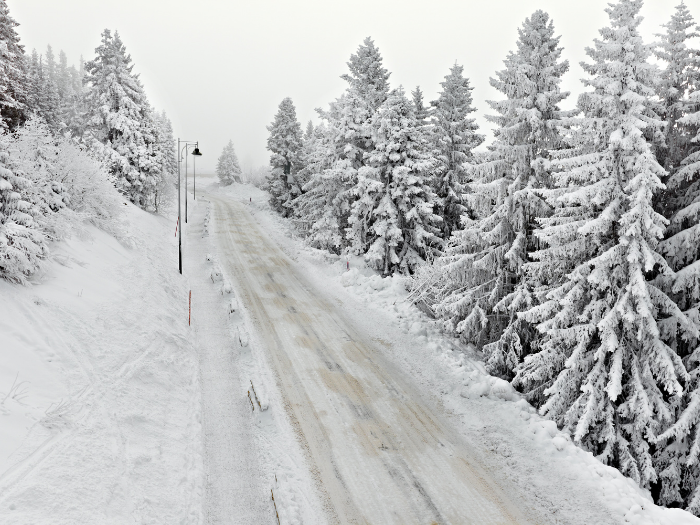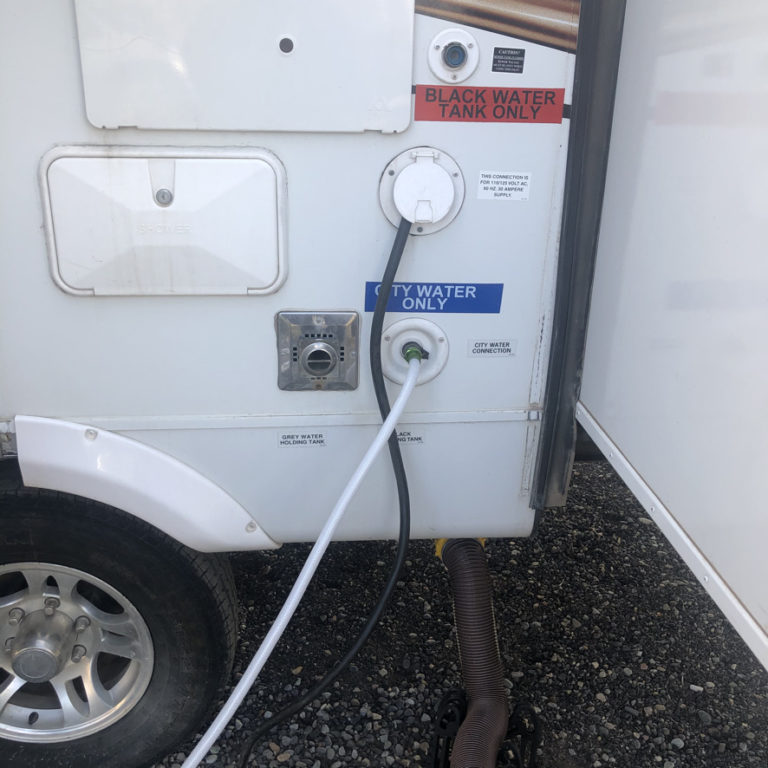Can RV Antifreeze Freeze? What You Need to Know
NOTE*** The content on this page may contain affiliate links, we may make a commission. And, as an Amazon Associate, we earn from qualifying purchases. More information: disclosure page.
RV antifreeze is great in protecting your plumbing system during winter. It’s a must-have maintenance material for your rig. But it’s important to know its freezing capabilities, especially on very cold days.
Does RV antifreeze freeze?
In short, yes – RV antifreeze can freeze. While it’s available in -50F and -100F forms, RV antifreeze will freeze and burst pipes in an RV if temperatures drop too low. At its freezing point, the fluid will begin to crystallize and turn slushy. However, the damage to pipes will not occur until the rating (-50F or -100F) or burst point is reached.
In this article, we will go into more detail on when RV antifreeze will freeze – as well as other important information to know – to help you prevent any damage.
Here are some other posts about winterizing your RV:
What Is RV Antifreeze?

RV antifreeze is a liquid additive that is designed to lower the freezing point of another water-based liquid. It helps to regulate temperature and prevent damage to the RV piping system caused by freezing winter temperatures. Antifreeze contains propylene glycol, ethanol, or a mix of both. It is pumped through the system to replace any water that is left in the pipes.
When water freezes, it expands. This expansion on your plumbing system can cause it to crack and burst.
Adding RV antifreeze to your piping system will lower the freezing point of any water left in the pipes so that it does not expand as quickly during winter.
RV antifreeze is different from automotive antifreeze. Beyond the difference in color, pink vs blue, RV antifreeze is non-toxic. It is meant to be used in an RV.
How Do I Winterize My RV?
Winterizing your RV requires more than just putting antifreeze into your RV’s piping. First, empty all your water storage tanks. Drain all your fresh water tanks and lines. You also have to drain, flush, and clean your toilet, as well as gray and black water tanks.
If you have a water heater tank, you must also drain this as well as all sinks, showers, and faucets.
For more detailed information on how to properly winterize your RV, please use our “Guide to Winterizing Your RV“
What is the Freezing Point for RV Antifreeze?
The temperature that RV antifreeze will freeze at depends on what grade you buy – this will be either -50 degrees Fahrenheit or -100F. “-50F” and “-100F” indicate the grade, or the temperature at which the liquid will freeze and expand. This is the point at which pipes will begin to burst (aka “freeze point” or “burst point”).
The -50F RV antifreeze will begin to freeze at +20F. At this point it will begin to crystallize and become slushy. However, -50F antifreeze will not completely freeze and cause damage until temperatures reach -50F.
The -100F grade antifreeze will begin to freeze at -20F but can be safely used to -100F.
Freezing Point for Antifreeze Compared to Water
To illustrate what temperature does RV antifreeze freeze at, the table below compares the RV antifreeze freeze point vs. water freeze point.
| Liquid Type | Water | -50 RV Antifreeze | -100 RV Antifreeze |
| Freezing Point | 32 F (0C) | +20F (-6C) | -20F (-29C) |
| Burst Point | 32 F (0C) | -50 F (-45 C) | -100 F (-73C) |
How Much Antifreeze Does My RV Need?

You may need 1 – 5 gallons of RV antifreeze to properly winterize your camper depending on its size. The amount of antifreeze that you would need will also vary depending on your RV’s plumbing system size, your preferred method of winterization, and the brand of antifreeze you’re using.
Here we will use the brand “Camco” RV antifreeze as an example. On the Camco label, the recommended amounts needed are:
- RV without water tank or toilet – 1gallon
- RV under 18 ft. – 2 gallons**
- RV 18-28 ft. – 3 to 4 gallons**
- RV 28-40 ft. – 4 to 5 gallons
**Provided water heater and holding tanks are in bypass mode
I use 4 gallons for my 35-foot travel trailer. The water heater is bypassed. However, I add about a gallon to each holding tank.
To have an idea of how much you would need, check the label of your RV antifreeze. It is also smart to have at least 1-gallon extra in case the estimate on the label is not enough.
Caution: Do not dilute RV antifreeze with water. This will lessen the protection capacity of your RV antifreeze and defeat its purpose.
Are There Other Ways to Winterize My RV?

There are other ways to winterize your RV if you prefer not to use antifreeze. Some people use the “Air Compression Method”. With this method, every tank on your RV is drained and blown out with an air compressor until no water is left.
This method can be risky as water may often get left in the traps and corners of your plumbing system. Even small amounts of water can freeze and cause cracks in your plumbing.
In addition, high air pressure can damage your plumbing system that may go unnoticed. If you do not know how to properly do this method, it can really be hazardous to your RV.
Finally, you can also bring your RV to experts and have them winterize it for you. This is the easiest option, but may also be the most expensive.
What Happens When RV Antifreeze Freezes?
When RV antifreeze passes the temperature it’s designed for, or it’s “grade,” it will begin to freeze and expand. This can cause plumbing pipes to crack and burst.
-50F grade RV antifreeze (like this one) will become slushy at +20F but will freeze and burst pipes at -50F. The -100F grade antifreeze (which you can buy from Amazon too) will slush at -20F but can be safely used to -100F at which point it will freeze.
The freezing point of an RV antifreeze may differ with various brands but will be noted on the label.
Also, do not dilute your RV antifreeze with water. The freezing and bursting points will be reduced if mixed with water, which is why you should not use water to dilute your RV antifreeze.
Different Types of RV Antifreeze
There are three types of RV antifreeze: ethanol-based, propylene glycol-based, and a propylene-ethanol blend. The label of your RV antifreeze will tell you which type it is.

Keep reading to learn more about each type of RV antifreeze available.
Ethanol-Based RV Antifreeze
Ethanol-based RV antifreeze contains – you guessed it – ethanol. This is sometimes called “alcohol-based” as well. This type of antifreeze is widely available and inexpensive but can be dangerous.
Ethanol is flammable and can also leave a nasty taste in the water system even after being flushed out.
Using ethanol-based RV antifreeze can also deteriorate the rubber seals in your valves and pump.
This is the only of the three antifreeze types that is not recommended for consumption.
Ethanol-based RV antifreeze has a -50 degrees Fahrenheit burst point.
Propylene-Glycol Based RV Antifreeze
Propylene-glycol is the most expensive option for an RV antifreeze, but is most preferred for your RV’s water system.
Propylene-glycol RV antifreeze is odorless, tasteless, and non-toxic, making it safe to be placed in your water system.
It can also be used as a lubricant on your traps and seals to prolong their life or use.
This type typically has up to -100 degrees Fahrenheit burst point.
Propylene Ethanol Blend RV Antifreeze
Propylene Ethanol Blend RV antifreeze is a mixture of ethanol and propylene glycol. This offers the benefits of both types in one jug.
This blend is also non-toxic, making it safe for your plumbing system. However, since there is still ethanol in it, it can cause damage to your rubber seals with frequent use.
What’s the Difference Between RV Antifreeze and a Regular Car Antifreeze?
The main difference between an RV antifreeze and a regular car antifreeze is the chemical makeup and purpose. The main purpose of vehicle antifreeze is to keep the car’s fuel and engine from freezing, whereas RV antifreeze keeps water and plumbing systems from freezing.
A regular car antifreeze also contains components that may be toxic and dangerous. RV antifreeze is generally non-toxic and safe.
How To Tell Apart RV and Auto Antifreeze
It is usually easy to tell the difference between RV antifreeze and car antifreeze – you just need to look at it. RV antifreeze is generally pink; however, always double-check the label as it can sometimes be blue. On the other hand, car antifreeze is usually green/blue, but may come in yellow.
Final Thoughts on RV Antifreeze
Technically, an RV antifreeze can freeze, but not into solid ice. It can harden and slowly expand until it reaches its freezing and bursting point. The burst point will damage the water lines and destroy the plumbing.
It is very important to winterize your RV before winter arrives. You can do this by either applying an antifreeze to your system or doing the air compression method by yourself, or by hiring professionals to winterize your RV for you.
Winterizing your RV can take time, but will help you avoid future problems with your RV’s plumbing system.
Remember, if you’re winterizing your RV yourself, do not dilute your antifreeze with water. This will reduce the protection capacity of your antifreeze.
Always use an RV antifreeze and not auto antifreeze to avoid problems brought by using the wrong type.
When winter arrives, I hope this article helps prepare you for a safe and successful next RV season.
It’s a good idea to plan ahead, especially if you’re thinking of doing some winter camping. My Etsy Store has amazing planners and journals you can take with you on your next camping trip. They also make wonderful gifts for friends and family members who enjoy camping as well.

For more winter driving tips and destinations in an RV check these out:
- Winter Driving Safety Checklist for a Road Trip (34 Expert Tips)
- 9 Fun, Free Winter Activities in Colorado
- 11 Magical Places to Camp this Christmas (Best Winter Camping Destinations)
- 11 Breathtaking RV Destinations for December ( for Winter camping)


Hi, I’m Shauna – Welcome to Family Travel Fever. We are a large family, that was bitten by the travel bug! I take the kids by myself because I don’t mind flying or driving solo with my crew to discover the coolest places.
Sign up for our email list for my best travel tips plus get the family travel planner free.







We used RV antifreeze from Camco in our sump well to keep the line from freezing in extreme temps. I especially like that this is in concentrate form, so it’s lightweight at only 36 oz/jug. I just pour it straight into the sump well and it dilutes itself. It’s non-toxic, even in large quantities, and so is entirely safe indoors and out. In addition, it can protect the piping system even if the temperature drops to -50 degrees Fahrenheit.